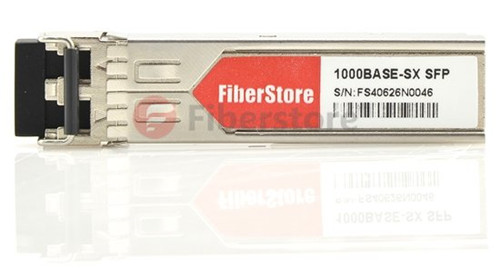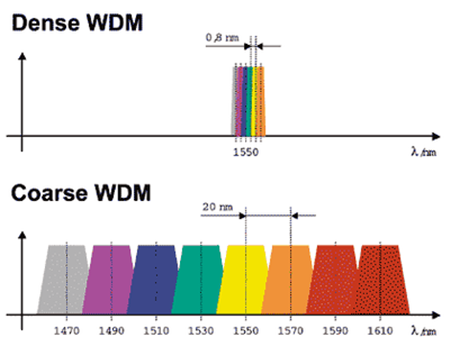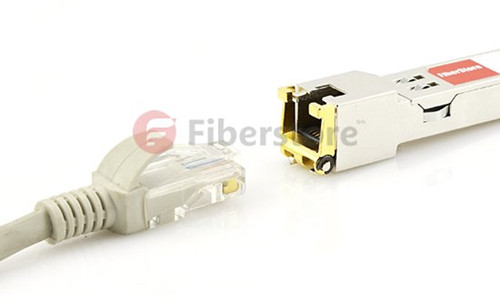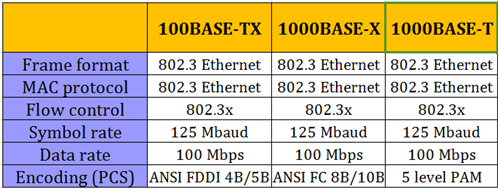Introduction to SFP+ transceiver
The small form-factor pluggable plus (SFP+) transceiver is based on SFP and developed by the ANSI T11 fibre channel group. SFP+ has become the most popular socket on 10GE systems due to its smaller size and lower power. SFP+ modules can further be grouped into two types of host interfaces: linear or limiting. Limiting modules are preferred except when using old fiber infrastructure which requires the use of the linear interface provided by 10GBASE-LRM modules.
The small form-factor pluggable plus (SFP+) transceiver is based on SFP and developed by the ANSI T11 fibre channel group. SFP+ has become the most popular socket on 10GE systems due to its smaller size and lower power. SFP+ modules can further be grouped into two types of host interfaces: linear or limiting. Limiting modules are preferred except when using old fiber infrastructure which requires the use of the linear interface provided by 10GBASE-LRM modules.
10 Gigabit Ethernet Standards
10 Gigabit Ethernet is a group of computer networking technologies for transmitting Ethernet frames at a rate of 10 gigabits per second. It was first defined by the IEEE 802.3ae-2002 standard. Like previous versions of Ethernet, 10GbE can use either copper or fiber cabling. However, because of its bandwidth requirements, higher-grade copper cables are required: category 6a or Class F/Category 7 cables for links up to 100m. The 10 Gigabit Ethernet standard encompasses a number of different physical layer (PHY) standards. A table is listed below to offer you a visual impression of the standards of 10 Gigabit Ethernet.
10 Gigabit Ethernet is a group of computer networking technologies for transmitting Ethernet frames at a rate of 10 gigabits per second. It was first defined by the IEEE 802.3ae-2002 standard. Like previous versions of Ethernet, 10GbE can use either copper or fiber cabling. However, because of its bandwidth requirements, higher-grade copper cables are required: category 6a or Class F/Category 7 cables for links up to 100m. The 10 Gigabit Ethernet standard encompasses a number of different physical layer (PHY) standards. A table is listed below to offer you a visual impression of the standards of 10 Gigabit Ethernet.
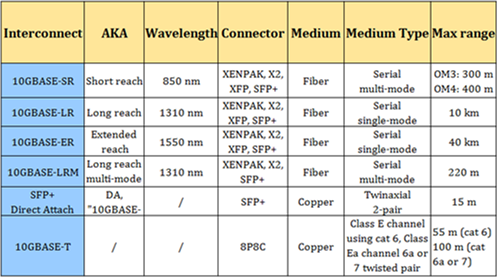
Types of SFP+ transceiver for 10 Gigabit Ethernet
SFP+ transceiver complaint with the 10 Gigabit Ethernet standards can be classified into 10GBASE-T SFP+, 10GBASE-SR SFP+, 10GBASE-LR SFP+, 10GBASE-ER SFP+, 10gBASE-LRM SFP+, etc. Next I will provide a brief introduction of the most common SFP+ transceivers for 10 Gigabit Ethernet—10GBASE-SR SFP+, 10GBASE-LR SFP+, 10GBASE-ER SFP+.
SFP+ transceiver complaint with the 10 Gigabit Ethernet standards can be classified into 10GBASE-T SFP+, 10GBASE-SR SFP+, 10GBASE-LR SFP+, 10GBASE-ER SFP+, 10gBASE-LRM SFP+, etc. Next I will provide a brief introduction of the most common SFP+ transceivers for 10 Gigabit Ethernet—10GBASE-SR SFP+, 10GBASE-LR SFP+, 10GBASE-ER SFP+.
10GBASE-SR SFP+
The 10GBASE-SR SFP+ is a port type of multi-mode fiber and uses 850nm lasers. Over OM1, it has a range of 33 m, over OM2 a range of 82 m, over OM3 300 m and over OM4 400 m. 10GBASE-SR delivers the lowest cost, lowest power and smallest form factor optical modules, which was projected to make up a quarter of the total 10GbE adapter ports shipped in 2011. Take 10GB-SR-SFPP ( see in the below image) as an example, it is fully compatible with Extreme devices and the SFP+ 20-pin connector to allow hot plug capability.
The 10GBASE-SR SFP+ is a port type of multi-mode fiber and uses 850nm lasers. Over OM1, it has a range of 33 m, over OM2 a range of 82 m, over OM3 300 m and over OM4 400 m. 10GBASE-SR delivers the lowest cost, lowest power and smallest form factor optical modules, which was projected to make up a quarter of the total 10GbE adapter ports shipped in 2011. Take 10GB-SR-SFPP ( see in the below image) as an example, it is fully compatible with Extreme devices and the SFP+ 20-pin connector to allow hot plug capability.
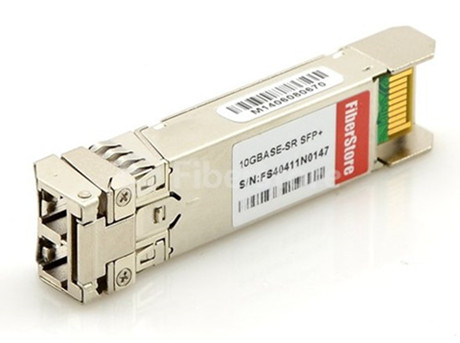
10GBASE-LR SFP+
10GBASE-LR SFP+ is designed for single-mode fiber and operates at a nominal wavelength of 850 nm. The 10GBASE-LR transmitter is implemented with a Fabry–Pérot or Distributed feedback laser (DFB). DFB lasers are more expensive than VCSELs but their high power and longer wavelength allow efficient coupling into the small core of single-mode fiber over greater distances. Compared with 10GBASE-SR, the maximum range of 10GBASE-LR is 10 km.
10GBASE-LR SFP+ is designed for single-mode fiber and operates at a nominal wavelength of 850 nm. The 10GBASE-LR transmitter is implemented with a Fabry–Pérot or Distributed feedback laser (DFB). DFB lasers are more expensive than VCSELs but their high power and longer wavelength allow efficient coupling into the small core of single-mode fiber over greater distances. Compared with 10GBASE-SR, the maximum range of 10GBASE-LR is 10 km.
10GBASE-ER SFP+
10GBASE-ER SFP+ transmits over single-mode fiber. Its operating wavelength is 1550 nm. This kind of SFP+ module is used to connect devices both in the same cabinet and in different physical locations up to 40km in distance that is widely used in large building, co-location facilities and carrier neutral internet exchanges.
10GBASE-ER SFP+ transmits over single-mode fiber. Its operating wavelength is 1550 nm. This kind of SFP+ module is used to connect devices both in the same cabinet and in different physical locations up to 40km in distance that is widely used in large building, co-location facilities and carrier neutral internet exchanges.
Conclusion
SFP+ transceiver is widely used to support communication standards including synchronous optical networking (SONET)/synchronous digital hierarchy (SDH), gigabit ethernet and fiber channel. From this text, we have acquired some information about SFP+ transceiver for 10 Gigabit Ethernet. Fiberstore manufactures a complete range of SFP+ transceivers such as 10GB-SR-SFPP, SFP-10G-ER, JG234A, etc. For more information, please feel free to contact us.
SFP+ transceiver is widely used to support communication standards including synchronous optical networking (SONET)/synchronous digital hierarchy (SDH), gigabit ethernet and fiber channel. From this text, we have acquired some information about SFP+ transceiver for 10 Gigabit Ethernet. Fiberstore manufactures a complete range of SFP+ transceivers such as 10GB-SR-SFPP, SFP-10G-ER, JG234A, etc. For more information, please feel free to contact us.

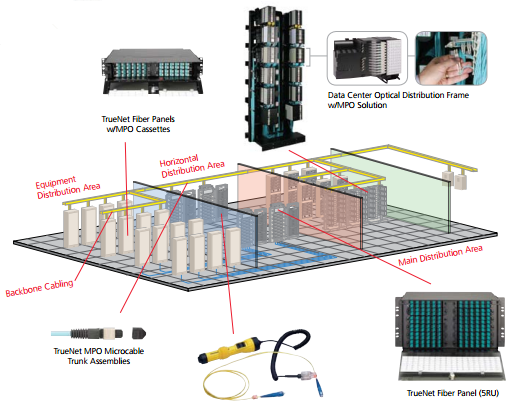
 And China's online retail phenomenon, Alibaba, now has a US stock market valuation of more than $210bn.
And China's online retail phenomenon, Alibaba, now has a US stock market valuation of more than $210bn.
